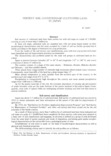Present Soil Conditions of Cultivated Land in Japan
Tropical agriculture research series : proceedings of a symposium on tropical agriculture researches
| ISSN | 03889386 |
|---|---|
| NII recode ID (NCID) | AA00870529 |

Full text
tars15-_97-103.pdf943.39 KB
Soil surveys of cultivated land have been carried out with soil maps at a scale of I :50,000, covering an area of more than 5 million ha.
In these soil maps, cultivated soils are classified into 320 soil series based mainly on their morphological characteristics and the areas occupied by a kind of soil are further grouped into 4 classes according to the degree of limitation for crop production.
From the results of the soil surveys and classifications, areas with low crop productivity have been identified and soil improvement practices recommended.
The characteristics and problems posed by the main soil groups in cultivated land are described.
Japan is situated between latitudes 24° to 46° N and longitudes 123° to 146° E, and covers a total area of about 37 million ha.
The country consists of a chain of five main islands - Hokkaido, Honshu, Shikoku, Kyushu and Okinawa - and their satellite islands.
These islands have a large number of relatively high mountains which include many volcanoes.
Consequently, more than 60% of the land has a slope steeper than 15°.
Mean annual temperature is quite variable from the northern part of the country to the southern part and ranges from 6°C to 22°C.
Precipitation is comparatively high throughout the country and mean annual precipitation ranges from 1100 mm to 2500 mm.
As for the parent materials of the soil, the extensive deposition of volcanic ash and presence of acidic intrusive rocks are the main features of the parent material of the soils in Japan. Consequently, most soils of upland fields are undergoing intensive leaching and have low base status in natural condition.
In these soil maps, cultivated soils are classified into 320 soil series based mainly on their morphological characteristics and the areas occupied by a kind of soil are further grouped into 4 classes according to the degree of limitation for crop production.
From the results of the soil surveys and classifications, areas with low crop productivity have been identified and soil improvement practices recommended.
The characteristics and problems posed by the main soil groups in cultivated land are described.
Japan is situated between latitudes 24° to 46° N and longitudes 123° to 146° E, and covers a total area of about 37 million ha.
The country consists of a chain of five main islands - Hokkaido, Honshu, Shikoku, Kyushu and Okinawa - and their satellite islands.
These islands have a large number of relatively high mountains which include many volcanoes.
Consequently, more than 60% of the land has a slope steeper than 15°.
Mean annual temperature is quite variable from the northern part of the country to the southern part and ranges from 6°C to 22°C.
Precipitation is comparatively high throughout the country and mean annual precipitation ranges from 1100 mm to 2500 mm.
As for the parent materials of the soil, the extensive deposition of volcanic ash and presence of acidic intrusive rocks are the main features of the parent material of the soils in Japan. Consequently, most soils of upland fields are undergoing intensive leaching and have low base status in natural condition.
| Date of issued | |
|---|---|
| Creator | K. ABE |
| Publisher | Japan International Research Center for Agricultural Sciences |
| Volume | 15 |
| spage | 97 |
| epage | 103 |
| Language | eng |
